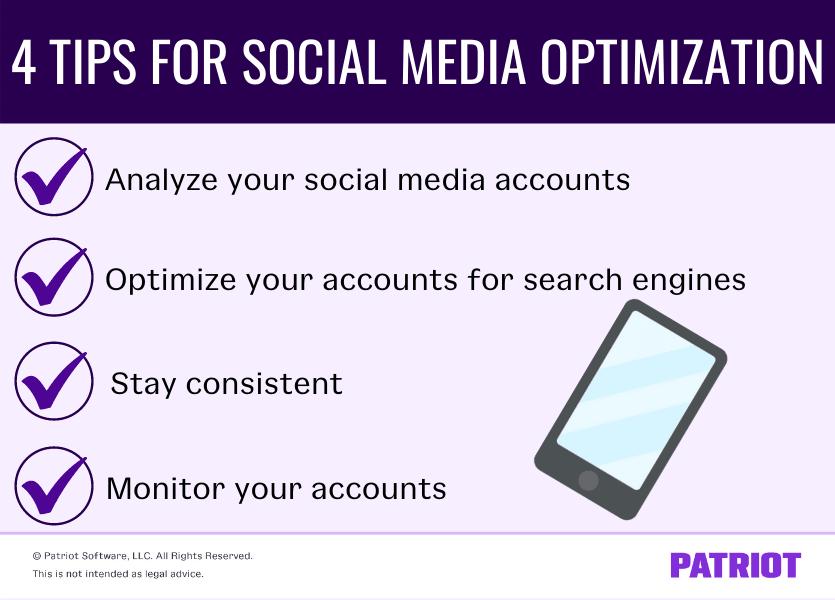A big part of your goals when running a business is to sell your products or services to gain a profit, right? So, that means that you want to use every way possible to sell, sell, sell. With the rise and massive presence of social media, you might be thinking this is a good way to do just that. But, how exactly can you use social media to maximize marketing and optimize your sales? Take a look at a few social media optimization tactics to get started.
What is social media optimization?
Remember the days of strolling through the mall only to be bombarded by salespeople at every other kiosk? That’s how social media marketing can feel to a lot of consumers. Every other post these days is an ad or sales pitch. But, social media is made for people to be social.
So, how can you use social media optimization tips to cut through the clutter people see as they scroll? And, what exactly is social media optimization?
You might already know phrases like search engine optimization (SEO) or conversion rate optimization (CRO). Now it’s time to learn about SMO. What is SMO? Social media optimization (SMO) is the practice of analyzing, auditing, and adjusting social media strategies. Like with SEO and CRO, you constantly test what does and doesn’t work with SMO. But, social media optimization can be a little trickier.
So without further ado, let’s take a look at four tips on how to optimize your social media platforms.

1. Analyze your social media accounts
Before you start making any changes to your social accounts, take note of what you currently do. Your current online presence gives you a baseline for where you can improve or what you decide should completely change.
To determine your baseline, take a look at the following:
- Commonly used hashtags
- General content (e.g., captions)
- Keywords
- Frequency of your posts
- Branded logos (do they match your website and branding guidelines?)
- Landing pages
Once you have a general idea of what your accounts look like, decide if the current messaging aligns with your goals. And, determine if your business’s social media looks more like one big promotion or if it shows a more general idea of your brand.
Keep in mind that social media advertising is not a bad thing. But, you don’t want it to look like that mall kiosk where every single post sells your audience on your products.
Instead, analyze the ratio of product posts to purely social engagement posts. A one-to-one ratio may work, but you may need to add more engagement-only posts in the mix.
As your business grows, continue to analyze your accounts to identify any trends and make adjustments.
2. Optimize your social media for search engines
If you’re already working on optimizing your business website for SEO, take that a step further and apply it to your social media. To help search engines boost your social media pages, consider doing the following:
- Add the same contact information across all platforms (i.e., phone number, address, and business website)
- Use the same username for each social media account
- Complete your company’s bio or “About” section for each social platform
- Incorporate keywords from your website in your social posts and “About” sections
For example, say your business sells custom drinking tumblers, and that is a keyword phrase you use frequently on your website. Consider adding the keyword phrase “custom drinking tumblers” in your social media “About” sections and as a hashtag in your posts.
Be subtle with your keywords, and optimize when you use them. “About” sections and bios are prime spots for highlighting what your brand is about without overwhelming your posts with the same words, phrases, or hashtags. Consider looking for the best hashtags to use for small business to add to these sections, too.
Remember to also use links wherever possible. With the goal of driving traffic to your business and website, add links to the most relevant content on your social platforms. Consider creating specialized links (e.g., UTM codes in URLs) to help analyze where your traffic comes from, too.
3. Stay consistent with your SMO
Content is key for social media posts, so it can feel a little overwhelming to have to post on a schedule. But, the benefit of a schedule allows you to consistently stay in front of your audience and customers.
Use your baseline to determine the frequency of your current posts. Do you post once a week, twice, three times? What do your analytics tell you about your current posting schedule? If your analytics indicate low social media customer engagement, consider making adjustments to your schedule. If your engagement is high, stick to what you’re currently doing.
How do you know if you should post more frequently or less frequently? Experiment and run tests to determine if your engagement rate and other metrics improve. You can start by posting more frequently if you currently only post once or twice per week. Or, you may decrease your posting schedule to a few times per week if you currently post every day.
Perhaps the most important part to keep in mind about consistency is only posting good or engaging content. Do not post just to post. Instead, post when you have content that adds value to your platforms.
When you have good content ready to go, consider the best time of day to post, too. Studies suggest that the perfect time to post throughout the week is between 11:00 AM and 2:00 PM, with Tuesday being the most engaging day. The best times and days to post can vary based on the business, audience, and followers, too. So, check your analytics and track your business’s best posting times.
Finally, don’t post the same amount of content across each of your platforms. Vary the amount based on where you are posting. Social media sites like Facebook, Instagram, and LinkedIn are slower paced. On the other hand, posting more frequently on Twitter is more acceptable because it moves at a quicker pace.
4. Monitor your social media
So, you’ve analyzed, optimized, and scheduled your social media. Now, it’s time to monitor it.
Remember that social media is, again, social. When you post, monitor the engagements and respond to comments or questions promptly. After all, people do not want to be kept waiting.
One important item to remember is the number of followers. The more people who follow you, the more likely you are to have a potential customer in the mix. Keep in mind that your number of followers can vary from month to month. So, be sure to track how many followers you lose or gain per month, as it can indicate if your posts attract more potential customers over time.
You can use the analytics built into social platforms to track metrics, like engagement rates. Or, you can manually track (e.g., on a spreadsheet) how many likes, comments, or shares your posts receive. Consider tracking individual posts and total monthly engagement.
Monitoring your social media lets you keep track of what kinds of posts receive the most feedback or engagement. When you know what kinds of posts give you the most success, you can replicate them down the line.
For example, a giveaway post receives 50 comments, 100 likes, and 20 shares. That’s a big success, right? You may use that response as an incentive to host more competitions or giveaways in the future.
Likewise, if you post something that is exciting for your business and it receives little response, monitor what feedback you receive so you can improve in the future.
This is not intended as legal advice; for more information, please click here.
